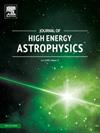A possible jet and corona configuration for Swift J1727.8–1613 during the hard state
IF 10.5
4区 物理与天体物理
Q1 ASTRONOMY & ASTROPHYSICS
引用次数: 0
Abstract
Swift J1727.8–1613 is a black hole X-ray binary that differs from other black hole X-ray binaries in that it has an extra hard component in addition to a reflection component. We perform spectral analysis with simultaneous Insight-HXMT, NICER and NuSTAR observations when the source was in the hard and hard intermediate states. For the presentation of the extra components, we investigate the correlation between the relxill parameters. We find that the correlation between the spectral index and the reflection fraction is consistent with MAXI J1820+070 when the jet dominates the reflection. This provides the second sample to have such a correlation during an outburst. Interestingly, when the reflection component is attributed to the corona, the spectral fit results in a small reflection fraction and the correlation between the spectral index and reflection fraction is in agreement with the overall trend built-in You et al. (2023) with a large sample of outbursts from other X-ray binaries. Hence Swift J1727.8–1613 turns out to be the first sample to bridge the MAXI J1820+070 to the majority of X-ray binaries according to the dual correlations observed between the spectral index and the reflection fraction. We speculate that a configuration of a jet plus a hot inner flow may account for this peculiar outburst behavior of Swift J1727.8–1613.
在硬状态下,雨燕J1727.8-1613可能的射流和日冕结构
Swift J1727.8-1613是一个黑洞x射线双星,与其他黑洞x射线双星不同的是,除了反射成分外,它还有一个额外的硬成分。我们同时使用Insight-HXMT、NICER和NuSTAR观测数据,在源处于硬态和硬中间态时进行光谱分析。为了表示额外的分量,我们研究了弛豫参数之间的相关性。我们发现,MAXI J1820+070在喷流主导反射时,光谱指数与反射分数的相关性与MAXI J1820+070一致。这提供了在爆发期间具有这种相关性的第二个样本。有趣的是,当反射成分归因于日冕时,光谱拟合的结果是反射分数很小,光谱指数和反射分数之间的相关性与You等人(2023)利用其他x射线双星的大量爆发样本所建立的总体趋势一致。因此,根据光谱指数和反射分数之间的双重相关性,Swift J1727.8-1613被证明是第一个将MAXI J1820+070与大多数x射线双星桥接起来的样本。我们推测,射流加上内部热流的结构可能解释了Swift J1727.8-1613这种特殊的爆发行为。
本文章由计算机程序翻译,如有差异,请以英文原文为准。
求助全文
约1分钟内获得全文
求助全文
来源期刊

Journal of High Energy Astrophysics
Earth and Planetary Sciences-Space and Planetary Science
CiteScore
9.70
自引率
5.30%
发文量
38
审稿时长
65 days
期刊介绍:
The journal welcomes manuscripts on theoretical models, simulations, and observations of highly energetic astrophysical objects both in our Galaxy and beyond. Among those, black holes at all scales, neutron stars, pulsars and their nebula, binaries, novae and supernovae, their remnants, active galaxies, and clusters are just a few examples. The journal will consider research across the whole electromagnetic spectrum, as well as research using various messengers, such as gravitational waves or neutrinos. Effects of high-energy phenomena on cosmology and star-formation, results from dedicated surveys expanding the knowledge of extreme environments, and astrophysical implications of dark matter are also welcomed topics.
 求助内容:
求助内容: 应助结果提醒方式:
应助结果提醒方式:


